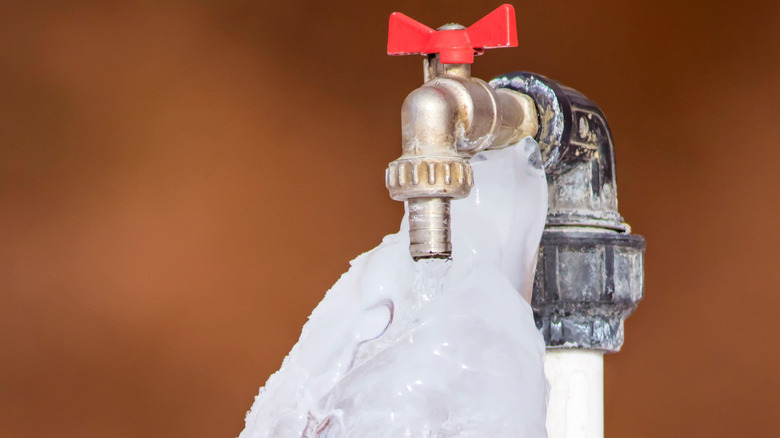Essential Tips to Avoid Frozen Plumbing in Winter
Essential Tips to Avoid Frozen Plumbing in Winter
Blog Article
We have come across the article pertaining to Prevent Frozen Pipes down the page on the internet and reckoned it made good sense to relate it with you here.

Winter can ruin your plumbing, particularly by freezing pipelines. Here's just how to prevent it from occurring and what to do if it does.
Intro
As temperature levels decrease, the danger of frozen pipes boosts, possibly leading to expensive repair work and water damage. Comprehending just how to stop frozen pipes is essential for house owners in chilly climates.
Avoidance Tips
Shielding at risk pipelines
Wrap pipes in insulation sleeves or make use of warmth tape to shield them from freezing temperature levels. Concentrate on pipelines in unheated or external areas of the home.
Heating techniques
Maintain indoor spaces sufficiently warmed, particularly areas with pipes. Open closet doors to allow warm air to circulate around pipelines under sinks.
Exactly how to recognize icy pipes
Seek lowered water flow from taps, unusual odors or noises from pipelines, and noticeable frost on exposed pipes.
Long-Term Solutions
Structural changes
Consider rerouting pipes away from exterior walls or unheated areas. Add additional insulation to attic rooms, basements, and crawl spaces.
Upgrading insulation
Purchase high-grade insulation for pipelines, attics, and walls. Proper insulation aids keep regular temperature levels and decreases the risk of icy pipes.
Safeguarding Outdoor Pipes
Yard pipes and outdoor taps
Detach and drain garden tubes before winter months. Mount frost-proof faucets or cover outdoor taps with protected caps.
Recognizing Icy Pipelines
What triggers pipelines to freeze?
Pipelines freeze when subjected to temperature levels below 32 ° F (0 ° C) for prolonged durations. As water inside the pipelines freezes, it expands, putting pressure on the pipe wall surfaces and possibly creating them to burst.
Risks and damages
Frozen pipes can cause water disruptions, home damages, and expensive repairs. Ruptured pipelines can flood homes and trigger extensive structural damages.
Signs of Frozen Water Lines
Recognizing icy pipes early can avoid them from breaking.
What to Do If Your Pipes Freeze
Immediate actions to take
If you think frozen pipes, maintain taps open up to relieve pressure as the ice melts. Use a hairdryer or towels soaked in hot water to thaw pipes slowly.
Conclusion
Preventing frozen pipelines calls for aggressive measures and quick responses. By comprehending the reasons, signs, and safety nets, homeowners can secure their plumbing throughout cold weather.
5 Ways to Prevent Frozen Pipes
Drain Outdoor Faucets and Disconnect Hoses
First, close the shut-off valve that controls the flow of water in the pipe to your outdoor faucet. Then, head outside to disconnect and drain your hose and open the outdoor faucet to allow the water to completely drain out of the line. Turn off the faucet when done. Finally, head back to the shut-off valve and drain the remaining water inside the pipe into a bucket or container. Additionally, if you have a home irrigation system, you should consider hiring an expert to clear the system of water each year.
Insulate Pipes
One of the best and most cost-effective methods for preventing frozen water pipes is to wrap your pipes with insulation. This is especially important for areas in your home that aren’t exposed to heat, such as an attic. We suggest using foam sleeves, which can typically be found at your local hardware store.
Keep Heat Running at 65
Your pipes are located inside your walls, and the temperature there is much colder than the rest of the house. To prevent your pipes from freezing, The Insurance Information Institute suggests that you keep your home heated to at least 65 degrees, even when traveling. You may want to invest in smart devices that can keep an eye on the temperature in your home while you’re away.
Leave Water Dripping
Moving water — even a small trickle — can prevent ice from forming inside your pipes. When freezing temps are imminent, start a drip of water from all faucets that serve exposed pipes. Leaving a few faucets running will also help relieve pressure inside the pipes and help prevent a rupture if the water inside freezes.
Open Cupboard Doors
Warm your kitchen and bathroom pipes by opening cupboards and vanities. You should also leave your interior doors ajar to help warm air circulate evenly throughout your home.

We had been made aware of that write-up about Prevent Frozen Pipes through an acquaintance on another domain. Are you aware of another person who is interested in 6 Ways to Prevent Frozen Pipes? Be sure promote it. Thanks for going through it.
Visit My Site Report this page